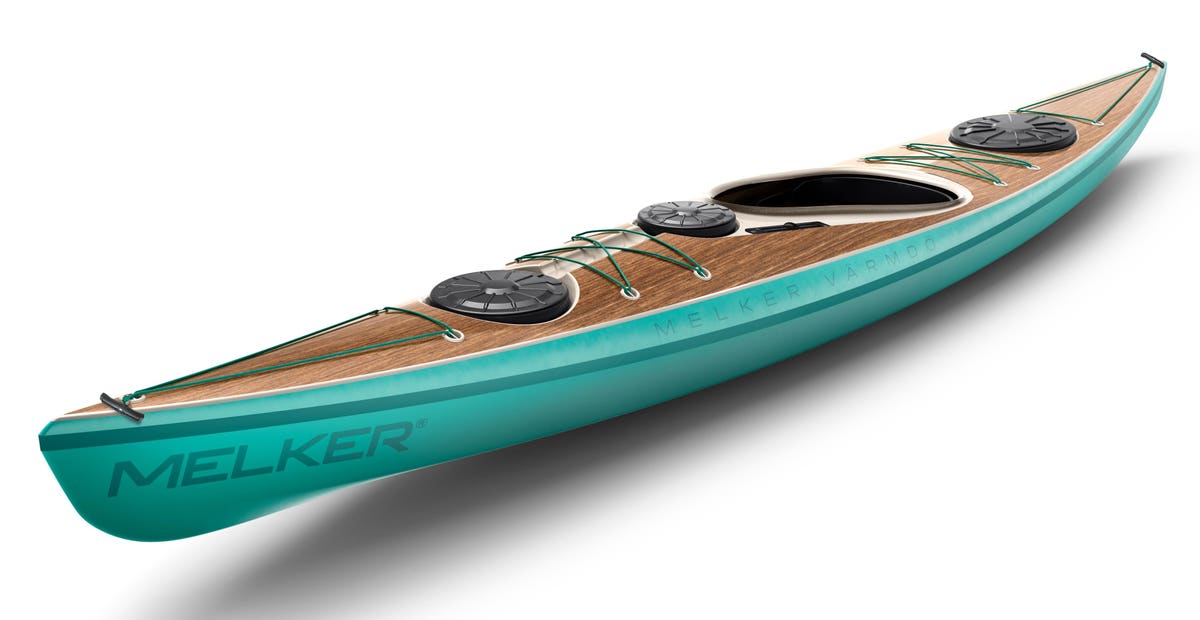Prototypes are how companies measure if a new product will sink or swim. At Melker of Sweden, a sport kayak maker, they take this product development stage quite literally — 3D printing full-size prototype kayaks in one piece to field test on the water.
Rapid prototyping with 3D printing has become relatively standard across industries. It’s cheaper and faster than injection molding and CNC machining, resulting in more efficient product development. Melker took it to the next level to develop a new kayak aimed at the North American market in only six months instead of two years, says company CEO & Creative Director Pelle Stafshede.
“At first, we were planning to enter the North American market with our existing portfolio of kayak models, but being there and meeting with customers, dealers, and sales reps, we understood that we needed to have a shorter and wider model to reach a broader target group,” he says.
Developing a completely new product would have put Melker’s expansion plans back years. The traditional way of developing a kayak goes from computer design to creating an expensive metal mold ($5,000 to $10,000) into which plastic is injected to form the first prototype. Changes require more molds and more prototypes, taking time and material, plus creating plastic waste.
“There are so many bad products in the world because companies can’t afford just that one more prototype that would have made it perfect,” says Stafshede. “People say, ‘We wish we could have lowered that or made that bigger, but we need to live with this.’ ”
3D printing enables nearly limitless prototypes because it can be done on-site or at a local 3D printing service at a fraction of the cost of traditional manufacturing. Being able to iterate and prototype until your design is just right enables Melker to make a better product, Stafshede adds.
Mass Prototyping Made Sustainable
Making multiple plastic prototypes sounds like it wold have sustainability drawbacks and material waste. Melker, however, 3D prints its prototypes from polymer sourced from off-cast fishing nets that are then infused with wood fiber, a plentiful byproduct of Sweden’s lumber industry. Then, the first prototype is ground up and used as material for the next prototype.
Melker of Sweden was founded with the ambition to make the outdoor hardware industry more sustainable. Even the final Melker kayaks are made with injection molding of mostly bio-based material with natural flax fibers and cork. It’s a sustainable approach that’s part of the Swedish identity, but not that top-of-mind for Americans, Stafshede says.
“There’s definitely a different mindset in America. Sales reps and customers are interested enough to listen, but there’s a reluctance to pay more for a boat being produced in a more sustainable manner.”
Within a few years, however, Stafshede sees sustainability becoming more important to consumers worldwide. He hopes to be using 100% plant-based materials in his full line of kayaks, which would be completely recyclable.
A Kayak Made For Americans
Back in Sweden from their North American market research, Melker designers got busy drafting the new more recreational kayak called the Värmdö. It’s wider, shorter, and more lightweight than the company’s Swedish-style sea kayaks. It’s also more comfortable, with extra padding and a more customizable-fit cockpit. There are no cup holders, but Stafshede says it was discussed.
North America is the largest kayak market in the world with expected 3.6% annual growth over the next 10 years fueled by a rising emphasis on adventure sports and the popularity of water sports, particularly kayaking competitions, according to Transparency Market Research.
Setting the Melker brand apart from the competition in the North American market, Stafshede believes, will be its design, sustainability story, and the fact that the Värmdö is made to last a lifetime.
Kayak-Size 3D Printers
The 3D printing technology behind the prototypes that made the Värmdö possible is very similar to the desktop version hobbyists use to churn out figurines and lampshades but on a much larger scale. Called robotic arm additive manufacturing, melted plastic is extruded layer by layer through a nozzle at the end of a robotic arm, fed by a hopper full of material. The robotic arm follows the path determined by the digital file.
Melker does not own its own 3D printers yet, instead working with the Research Institute of Sweden (RISE), which is partly government-funded. RISE gives companies like Melker access to high-tech equipment and the engineers that run it but Melker also pays for the access. Even without government funding, Stafshede says, the 3D-printed prototypes are affordable at a fraction of the cost of traditional ones.
Large-scale 3D printing is not widely available as a service from 3D printing companies — although its growing — and only a handful of companies make the equipment. The extruder heads, available from U.S.-based Massive Dimension or Canadian Dyze Design fit onto standard robotic arms, such as from Kuka or ABB. Full turnkey systems are available from 3D printer makers, such as Caracol and CEAD. The controlling software comes from the robotic arm makers or more specialized 3D-printing-focused companies, such as start-ups Ai Build and Adaxis.
Why Not 3D Print the Final Kayak?
“When the technology and the materials mature, [3D printing] is definitely going to be a very good way of producing kayaks because then you can have local production and mass customization,” says Stafshede. Melker achieved a company milestone in 2023 by bringing all manufacturing to Sweden.
In the long run, five to 10 years, Melker hopes to set up production in North America with 3D printers alongside traditional manufacturing to enable easy customization, but for now, its best use is for prototypes, says Stafshede.
“We see our innovation, design, research, and development as a long-term investment for our company, coming generations, and the great outdoors,” Stafshede says of his company’s philosophy. “Making the best products is crucial for saving the planet.”
Read the full article here





